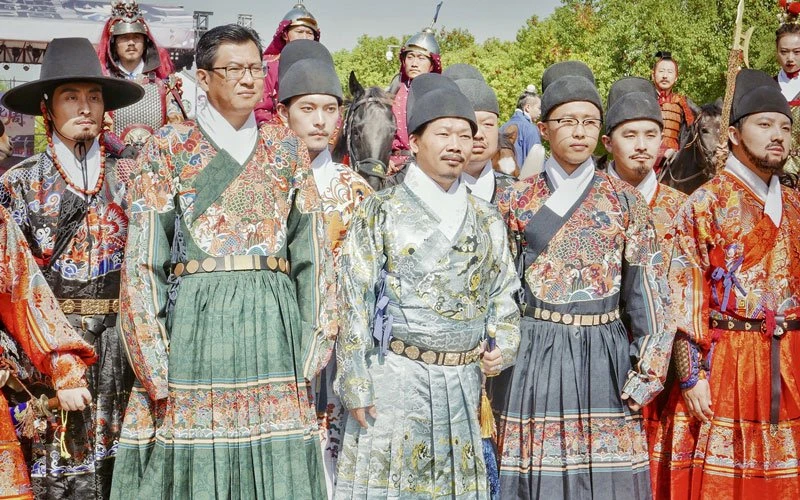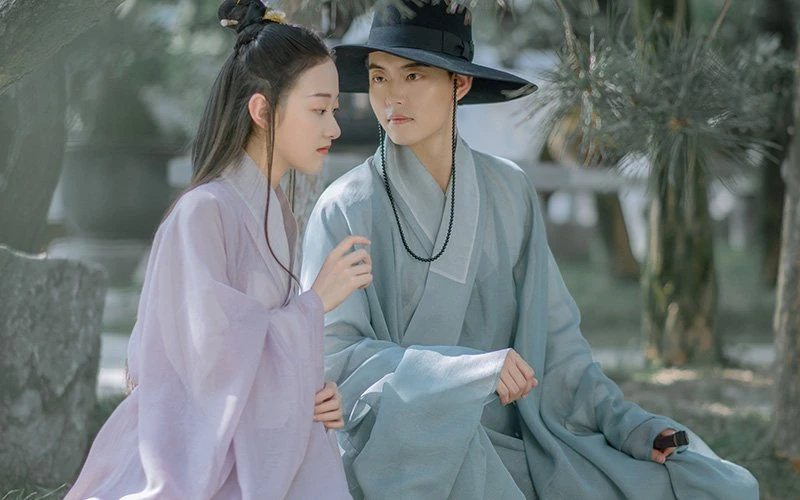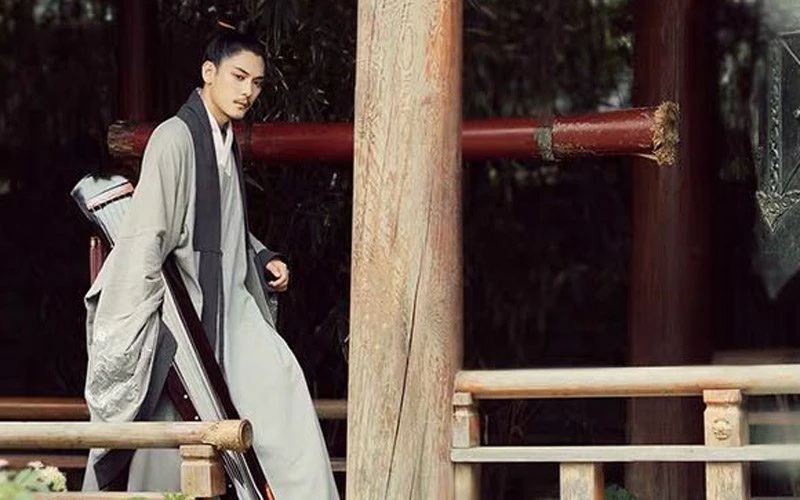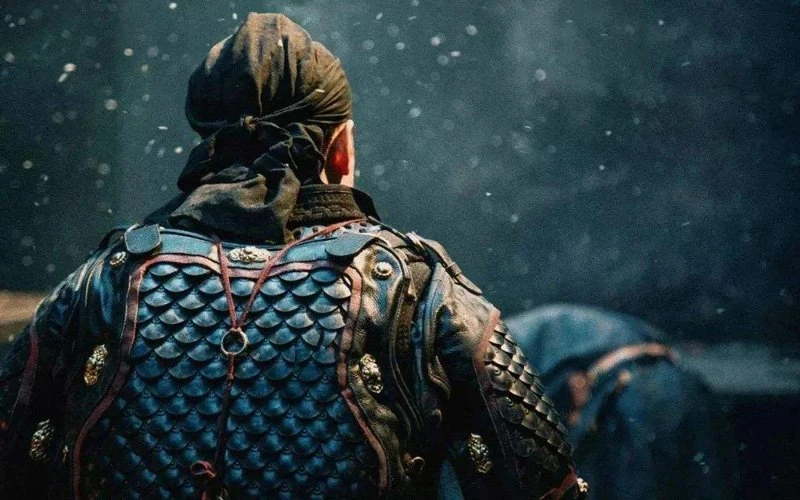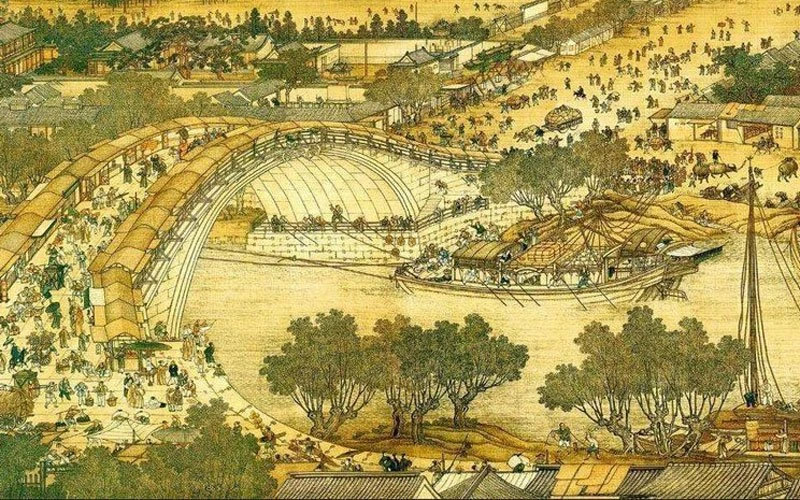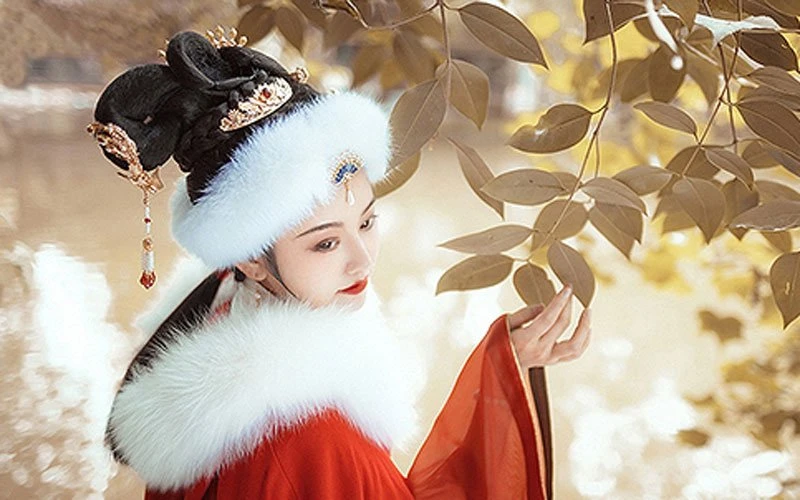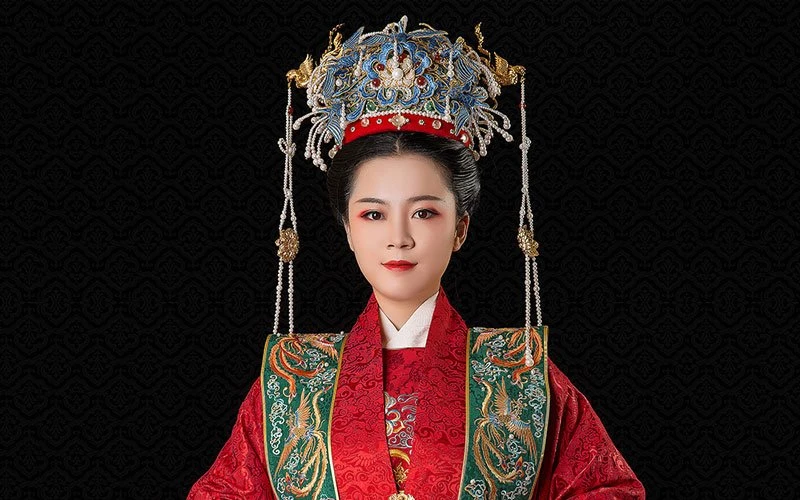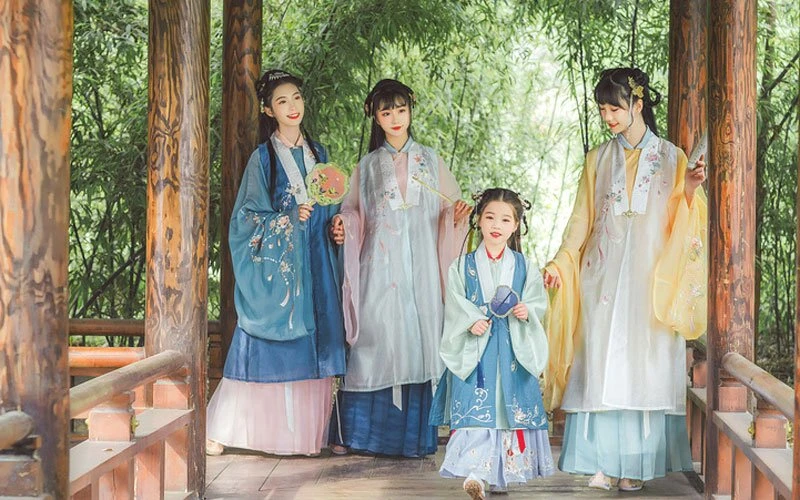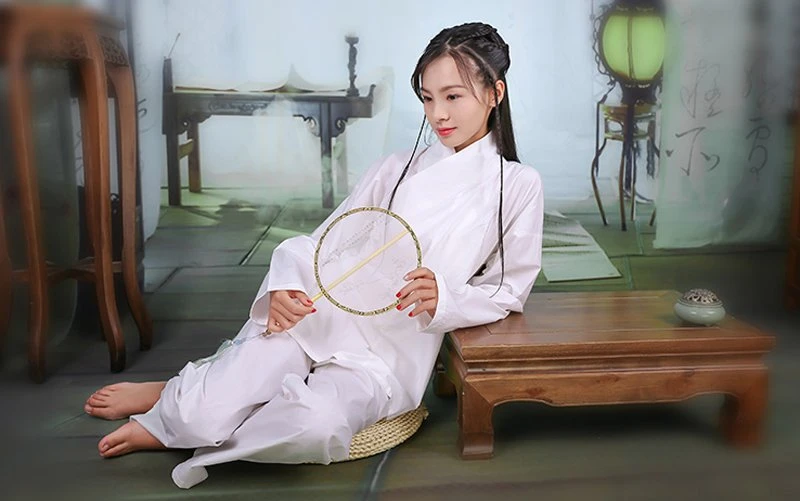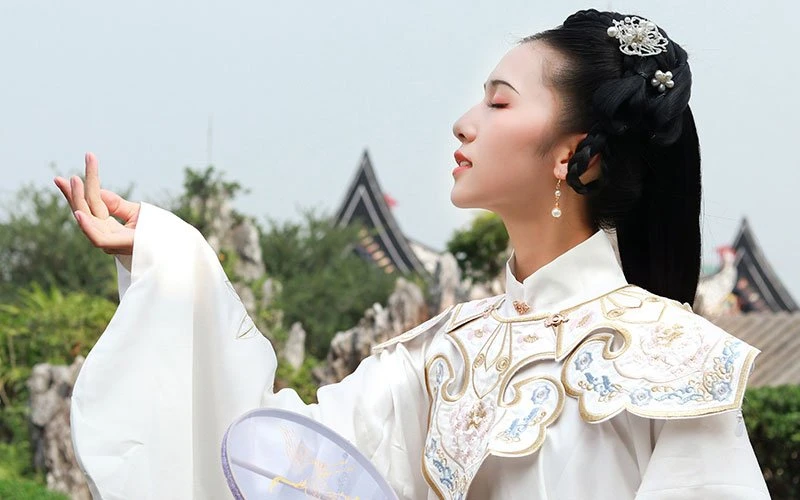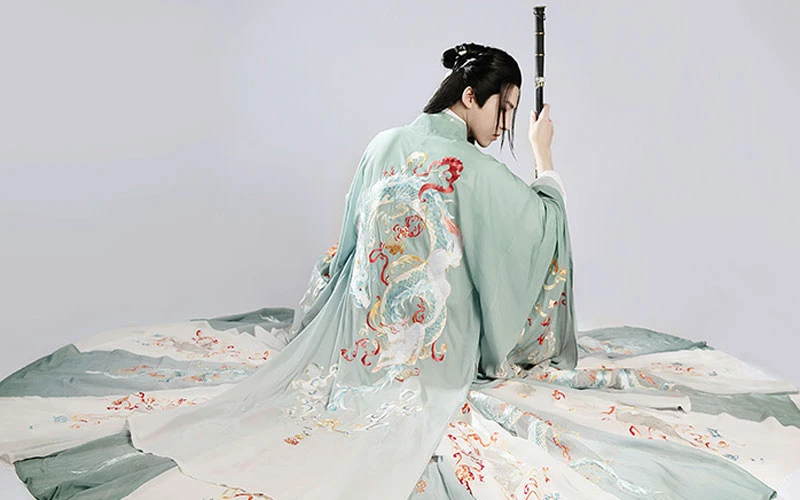
Various Types of Costumes in Hanfu
Introduction to the different styles of Hanfu, with historical background and picture presentation.
Total 39 Articles
Topics: 4
-
Ancient Chinese Robes for Men: Tieli & Yisan
We have previously detailed a few ancient Chinese robes from the Ming Dynasty (Zhiduo/Taoist/Zhishen), most of which are suitable for scholars, but today we will introduce you to 2 more martial styles ancient Chinese robes for men: Tieli & Yisan. You may often find these two classic Chinese costumes at Hanfu festivals or events, they are very eye-catching and handsome. Tieli (贴里) [History and characteristics of Tieli] Tieli is usually worn under a round-necked robe and Dahu (褡护, a type of clothing that belongs to the Banbi), which makes the wide hem of the robe slightly outward and dignified. Tieli is the Mongolian word for the robe and is an import from the Yuan Dynasty. After being inherited by the Ming Dynasty, the garment was lengthened, and the overall structure closer to Shenyi system of the Hanfu, and integrated the Han "orthodox" rituals, and later became the most common ancient Chinese robes, and is a common style of the Ming Dynasty officials (up to the Feiyu suit, down to military uniforms). Features of the Tieli include: Jiaolingyouren (交领右衽), the front and back of the garment are cut separates the top and bottom. Sleeves' styles are available in narrow and large,…...Ling
- 3.4k
- 0
-
Details of Zhishen - Ming Style Hanfu Outerwear
More than a decade ago, when the Hanfu movement was just gaining momentum, the more popular style of Hanfu outerwear was Shuhe (短褐). To this day, Hanfu has entered a shift to sophisticated and fashionable, and all we consider is what kind of shape is sophisticated, how to wear good-looking, and how to realize the two at the same time. As daily casual outerwear, it was clear that Duanhe could no longer meet this demand. In contrast, Zhiduo, Zhishen, round neck gown, and other forms will be more advantageous, today bring you the introduction of style is the Ming style Hanfu outerwear: Zhishen. [The structure and history of Zhishen] Zhishen, also known as Changyi (长衣), Haiqing (海青). Its structural features are very similar to "Taoist robes (道袍)". Ming Dynasty Liu Ruoyu "Zhuozhongzhi (酌中志)" records: "Zhishen, the system is the same as the Taoist robe, but hem swing in outside." Zhishen has several key features: The collar shape is Jiaoling Youren (交领右衽), also called "straight collar" because the collar style is slanting straight; Generally, one pair of laces is attached to the inner lapel and two pairs of laces are attached to the outer lapel to secure the lapel; Large sleeves; Slits…...Lin
- 2.5k
- 0
-
Daopao - Ming Style Hanfu Taoist Robe
What is the image that comes to your mind when you think of a Taoist robe? Is that a priest's robe? Or a Japanese cardigan? When we talk about traditional Chinese Hanfu, Taoist robes are usually referred to as one of the men's traditional Chinese costumes, also popular among the Ming Dynasty scholar's costumes. If there is any style of men's Hanfu that can be versatile, the robe must be the obvious choice. As you can see from its appearance, it is a very stylish Chinese man costume. Different styles of Taoist robes are suitable for people of all ages and temperaments, and Taoist robes with different clothing accessories will bring a completely different visual experience, which can be said to be the essential clothing for boys who are new to Hanfu. We'll start with a few photos to get a visual of the contemporary traditional Taoist robe. So let's learn more about the Daopao together! [Structure and History of the Taoist Robe] Taoist robe, once popular in the mid to late Ming Dynasty, developed from an earlier garment called "Zhe (褶)"; The collar shape is Jiaoling Youren (交领右衽), most collars will have an extra Huling (护领) sewn into them;…...Lin
- 5k
- 3
-
Details of Zhiduo - Ming Style Hanfu Jacket
If you like Hanfu, you may have seen all kinds of Hanfu jacket, But maybe you can't tell the difference between Zhiduo (直裰), Daopao (道袍), and Zhishen (直身), because they all look almost the same from the outside, but in fact, there are a lot of differences in the details, so let's get to know the "Zhiduo" today! [Structure and History of the Hanfu Jacket: Zhiduo] Zhiduo (直裰, also be called 直掇), has several key features: The collar shape is Jiaoling Youren (交领右衽, mean: crossed collars, tying to the right), Can be sewn a Huling (护领, sewn-on the collar area, mostly white and varying in width, to protect the collar from wear and tear and stains. In ancient times, the Huling was easy to dismantle and often replaced. Most of the Huling in contemporary Hanfu costume is preserved as a traditional feature.) on the collar. The making method of Zhiduo: Tongcai (通裁, cut in one piece, no seams on top and bottom). Usually narrow sleeves, but also straight or pipa sleeves. It is knee-length, and the length of the garment and the width of the sleeves vary according to the wearer's needs. The body of the garment is slit…...Lin
- 3.8k
- 0
-
15 Style Ancient Chinese Military Uniforms
In China's thousands of years of history, the ancient military uniform is also constantly changing according to the time. But ancient Chinese armor, due to problems with materials and preservation, few can be completely preserved to date, most can only be based on historical records and unearthed bits and pieces to speculate on research. Maybe we can see some relevant information through film and television works in our life. Today, let's review the evolution process of ancient Chinese military uniforms. Shang Dynasty (c. 1600-1046 BC) In the Xia dynasty, the scale of war is not big, more than thousands of participants, less than hundreds of people, but to the Shang dynasty, the scale of war becomes larger, sometimes up to tens of thousands of people, this time for the convenience of a unified order, the uniform was born, but this time the uniform is very simple, not too much of a protective role, only to improve the command of the army deployment. The armor of the Shang Dynasty was mostly leather and cloth armor, covering important parts of the body. Western Zhou Dynasty (1027-771 BC) The metal was already available during the Western Zhou Dynasty, but it had not been applied…...Lin
- 7k
- 1
-
What did Ancient Chinese Peasants Wear?
In modern society, everyone is equal. There is no difference in clothing. What you want to wear is optional. But in ancient times, there was a very strict hierarchy, which clearly stipulated that emperors, nobles, officials, rich people, ordinary people, servants, people of different identities had relevant dress regulations on different occasions. So what are the Chinese peasants wear? As early as the Xia and Shang Dynasties, the hierarchy of clothing has been initially established. In the Zhou Dynasty, a set of the more complete hierarchical system was established, and the form, texture, color, pattern, and ornament of clothing were specified in detail, which became an important part of the etiquette system of the Zhou Dynasty. Peasants, as the largest part of the ancient Chinese common people, mostly wore Duan Da (短打) clothes that could do farm work. Duan Da is a kind of ancient Chinese Hanfu, made of coarse cloth, include with top and lower trousers, the length of the coat is generally above and below the hips and knees. Duan Da is also called "Shu He (短褐, 裋褐)", the word "He (褐)" refers to clothing woven from hemp fabric or animal hair. So, the original meaning of the…...Lin
- 9.8k
- 1
-
Chinese Traditional Clothing Accessories - Moe
Moe (抹额), a kind of Chinese traditional clothing accessories, was popular in the Ming Dynasty. Moe tied on the forehead, usually decorated with embroidery or pearl jade. The application of Moe in the ancient army In the Tang Dynasty, Moe often appeared on the warrior's forehead. On the murals of the tomb of Prince Zhang Huai in the Tang Dynasty, there are warriors wearing red Moe. In the written records at that time, the word "Moe" appeared. Li He, a poet in the Tang Dynasty, once wrote a poem describing the drill of the water army: "water splashes on the Moe, flags, and drums will greet the tide at night." In the Five Dynasties, there was a "military Moe" clause. At that time, different colors were used as marks in the military to distinguish different armies. Moe - the mystery of women's beauty In the Song Dynasty, it was more used by women who loved beauty. Women's Moe in Song Dynasty became more exquisite in production. Historical materials also recorded that "ordinary families can't decorate jewelry, clothes, earrings, Moe and so on with pearls". Although women of ordinary status are not allowed to decorate Moe with pearls, their Moe styles…...Lin
- 2.1k
- 1
-
FengguanXiapei - The Most Luxury Ancient Female Chinese Wedding Dress
The ancient Chinese wedding dress, FengguanXiapei (凤冠霞帔), is the most secret dream of many ancient girls. In classical literary works and our imagination, FengguanXiapei often represents the conclusion of a good marriage, which is the most classic Chinese wedding dress. 1. What is "Fengguan"? Fengguan is the most solemn headdress in the Ming Dynasty. It is famous for its Phoenix-like ornaments. Fengguan had taken shape in the Han Dynasty. According to the records of historical materials, when the Empress Dowager participated in the sacrificial activities, she would wear jade ornaments in the shape of Phoenix. After the Han Dynasty, the headdress of Phoenix has been very popular. From the Song Dynasty, Fengguan was officially designated as the dress of Mingfu (命妇, women with titles in ancient times). When attending the important ceremony, Fengguan was needed. Apart from the dragon and phoenix, the gem is also an important part of Fengguan. According to the objects unearthed, the twelve dragon and nine phoenix crowns of the empress Xiaojing (孝靖皇后), including one hundred and twenty-one precious stones (fifty-three ruby, sixty-two sapphires, four emeralds and two pieces of topaz). Fengguan was a luxury that all the women of the Ming Dynasty longed for at that…...Lin
- 2.7k
- 3
-
History of Traditional Chinese Attire - Hanfu Beizi
Beizi (褙子), a kind of traditional Chinese attire, began in the Sui Dynasty, both men and women can wear it. The style of Beizi is mainly straight collar and Duijin, with no stitching from the armpit on both sides. It is often worn outside other clothes. Popular in Song and Ming Dynasties. Origin and development of Beizi Beizi began in the Sui Dynasty. There are two ways of saying about the origin of the name of Beizi, one is Beizi means that when a person walks, his back should be straight to support his back and body; the other is the clothes that Beizi used to wear by servant, because the servant often stands behind the mistress, so gets the name. In the Song Dynasty, both the queen and the nobility, as well as the maidservants and ordinary people, all liked to wear Beizi. At the same time, it is also the formal dress of women in the Song Dynasty. Style Song Dynasty In the Song Dynasty, there were three kinds of collar styles: straight collar style was worn by women; slant cross collar style; round collar style was worn by men on formal occasions. The length of the…...Lin
- 4.1k
- 1
-
A Brief History of Chinese Outfit for Girl - Bijia (vest)
Bijia (比甲) is a kind of Chinese outfit, it is a sleeveless and collarless vest, with two sides split to the knee. Its style is longer than that of the later vest, generally to the hip or knee, some longer, less than a ruler (about 33 cm long) from the ground. The main function is to keep warm, the advantage is very convenient, Bijia popular in the Yuan and Ming Dynasties. Origin & Development of Bijia Bijia was designed and made by the empress of Kublai Khan (the emperor of the Yuan Dynasty). At the beginning of the Yuan Dynasty, Bijia was worn by the emperor, and later gradually became popular among the people. Since the application of buttons in clothes appeared in the Yuan Dynasty, buttons have also been used in Bijia, which is more convenient and compact to wear. This is a new change in traditional Chinese outfits. Shape & Wear Style of Bijia In the Yuan Dynasty, Bijia was sleeveless and collarless, and the back of the garment was longer than the front, with two buttons made of thread on each side of the split, it was originally designed for the convenience of riding. The front chest…...Lucy
- 2.4k
- 0
-
What is Chinese Shirt - Hanfu Zhongyi Introduce
What is Chinese Shirt Zhongyi (Chinese shirt, 中衣), also known as Liyi (里衣), is the shirt of East Asian traditional clothing (Hanfu, kimono, Hanbok, etc.), which is worn between underwear and outerwear, mainly to match and set off. Most of them are white, which can be worn with a formal dress. Ordinary clothes can also be worn with a middle coat, which can be used as home clothes at the same time. Zhongyi is the basic clothing for wearing Hanfu. When wearing a formal dress, you must add a Chinese dress, just like a shirt in a suit. When wearing, the body and collar are more close-fitting than the coat, and the collar edge is slightly higher than the coat. Details of the Zhongyi (Chinese Shirt) Definition: Zhongyi refers to the Zhongyi of the top at the beginning, and later it also includes a narrow sleeve Zhongyi, a wide sleeve Zhongyi, as well as the Zhongqun (中裙) and Zhongdan(中单) with the same function. Fabric: general Chinese shirt fabric: pure cotton, cotton hemp, chiffon and monochrome satin. Color: in terms of color, the Zhongyi is basically white. When boys wear Round collar robe, it's better to wear a white Zhongyi. Girls…...Lin
- 5.2k
- 0
-
Classic Chinese Hanfu: Shoulder Accessories - Yunjian
You may often see Yunjian in Hanfu, but you may never know it in detail. But in fact, it is a very important role in ancient chinese costume. The history of Yunjian Yunjian (云肩, Cloud-shoulder), is mostly made of silk and satin brocade. It is often decorated with four cloud patterns and made of colorful brocade. It looks like clouds reflecting the sun after the rain and rainbow scattering in the clear sky. Therefore, it is called Cloud shoulder. Yunjian is an ornament worn on the shoulder by ancient women, is one of the important characteristics of Chinese Hanfu clothing, with rich decorative patterns and profound cultural philosophy. Before the Qin and Han Dynasty, there was no relevant written record. From the perspective of clothing style, it was influenced by the concept of nomadic people in the north and belonged to foreign clothing styles. The image was first seen in Dunhuang frescoes of the Sui Dynasty, and Guanyin Bodhisattva, who has been sinicized, has a Yunjian. By the Qing Dynasty (1644-1911), it was gradually popularized in all walks of life, especially in marriage, which became an indispensable dress for young women. Later, Yunjian were often worn in customary activities…...Lin
- 2.1k
- 1
